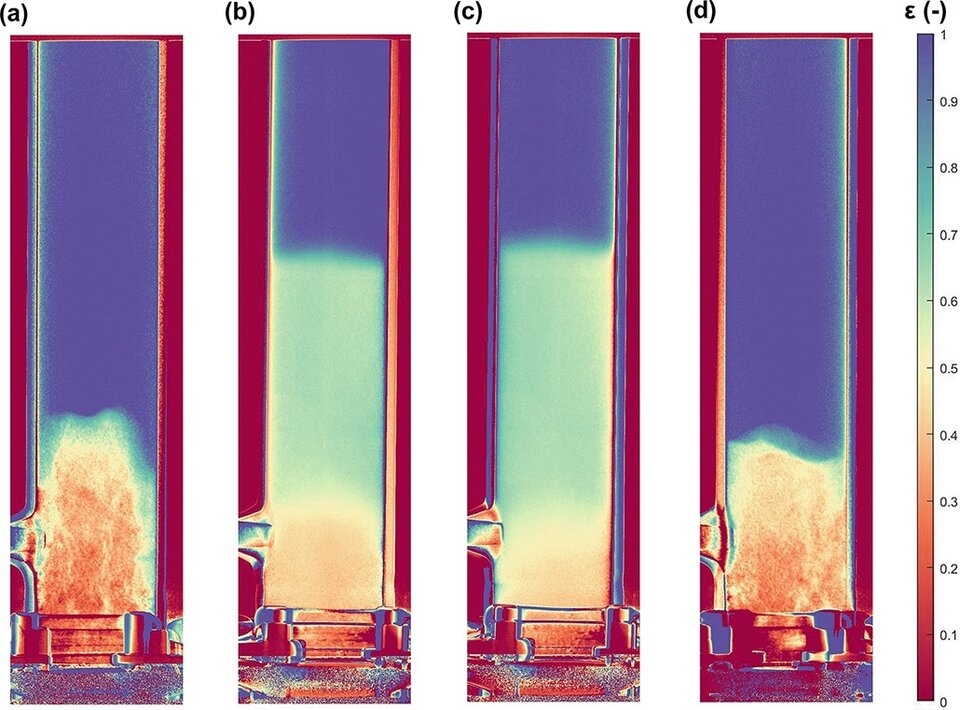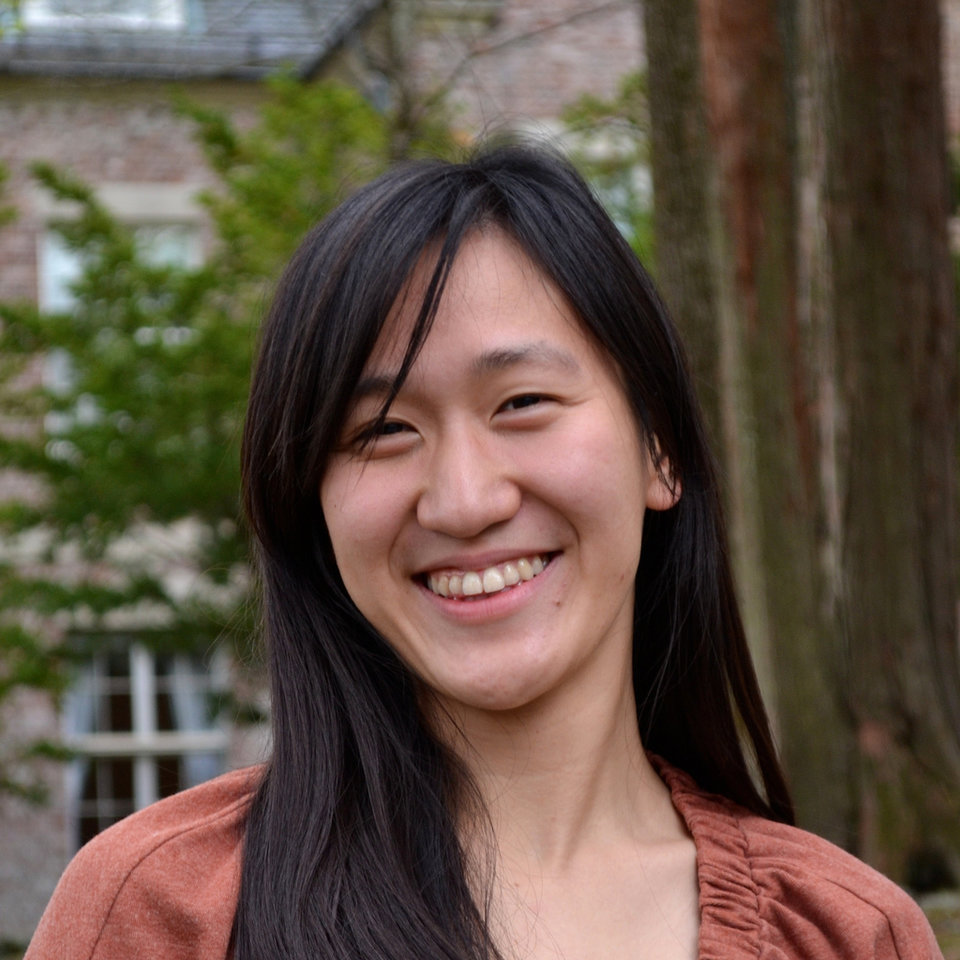Activate high contrast
To main content
News & Events

Effect of vibrational modes on fluidization characteristics and solid distribution of cohesive micro- and nano-silica powders
Fluidization of powders with small particle sizes is typically troublesome due to their cohesive nature. These powders to not transition from a packed bed into a homogeneous fluidizing one upon the introduction of a gas flow. Rather, they tend to stay mostly stationary, forming vertical channels through which the gas can escape. Several methods have been studied to overcome this behaviour and initiate fluidization, one of which is vertical vibration. We hypothesized that a horizontal component of the vibration would be more effective in disrupting the channelling, since the vibration would work perpendicular to the channel direction. In our work we compared the fluidization quality of beds of micro- and nano-particles, subjected vertical and elliptical (a combination of vertical and horizontal) vibration. In contrast to our expectations, we found that adding a horizontal component mitigated the effect of the vibrations, to the point that channels mostly remained present in the bed, whereas solely vertically vibrated beds showed full fluidization. Additionally, utilizing sectional pressure drop measurements, we showed improvements in fluidization behaviour with respect to the superficial gas velocity, which could not be acquired through conventional indicators of fluidization. Finally, we confirmed our results by X-ray imaging, where the presence or absence of channels could easily be demonstrated. Rens Kamphorst, Kaiqiao Wu, Matthijs van Baarlen, Gabrie M.H. Meesters, J. Ruud van Ommen Rens Kamphorst Go to the publication

NWO Vici for Atsushi Urakawa and Valeria Garbin
Valeria Garbin and Atsushi Urakawa each have obtained an NWO Vici grant of 1.5 M Euro. This is a highly competitive and prestigious grant, which will enable them to develop an innovative line of research and further expand their own research group for a period of five years. Vici is one of the largest personal scientific grants in the Netherlands and is aimed at advanced researchers. Learn more about their research. Flow physics of Pickering emulsion reactors for sustainable chemical conversion This project aims to unravel the flow physics of multicomponent, multiphase systems with complex interfaces, which are of emerging interest in areas ranging from advanced materials, to chemical conversion, to airborne disease transmission. These systems straddle the frontier between the field of fluid mechanics, where multicomponent systems are an emerging topic, and the field of colloid & interface science, where complex interfaces formed by surfactants, proteins or colloids can completely govern the overall flow behaviour. Understanding the role of complex interfaces on multicomponent, multiphase fluid mechanics is a formidable challenge because these systems are extremely complex, their phenomenology is very rich, and quantitative measurements are difficult. To overcome this challenge, we will develop a new interdisciplinary approach pushing the boundaries of fluid mechanics, colloid & interface science, and soft matter. Building on the latest advances in these fields, we will develop and integrate novel experimental approaches including in-situ, real-time visualization of concentration fields and advanced microstructure imaging, combined with multiscale modelling. Dr. Valeria Garbin V.Garbin@tudelft.nl As proof of principle, we will apply this new approach to the case of Pickering emulsions for chemical conversion. These water/organic emulsions stabilized by solid particles hold exciting potential as platforms for sustainable chemical processing, promising higher conversion rates and selectivity, and easier catalyst recovery. Despite promising lab-scale findings, industry-scale application of Pickering emulsions is hampered by the current lack of understanding of the flow physics involved. Our new approach will fill this gap in our fundamental description of Pickering emulsion reactors, enabling the development of mechanistic models to predict reactor performance which underpins the future design of a full-scale Pickering emulsion reactor. Operando description of catalytic activity from the reactor-scale gradients Heterogeneous catalysis plays vital roles in the production of chemicals and fuels, environmental protection and as enabler of future technologies towards sustainable and circular development. Innovative catalytic technologies are widely developed; however only a minute fraction of such technologies sees the commercial light after a long R&D of a few decades. With pressing environmental and energy issues we face, acceleration of these technology development and transfer steps are crucial. One major obstacle for this step is the complexity of catalytic processes occurring on different length scales varying from atomic to reactor scales. Ideally, catalytic performance (activity and selectivity) is precisely understood qualitatively in terms of reaction mechanism and quantitatively in terms of intrinsic reaction kinetics. With this information, in theory we can rationally propose novel materials and optimal reaction conditions and reactor types, leading to speed-up and higher success probability of commercialisation. Prof. Atsushi Urakawa A.Urakawa@tudelft.nl With this background, this project aims at methodological development towards acceleration of rational catalytic material and process design based on the information about physicochemical gradients present in catalytic reactors such as the gradients of fluid concentration, catalyst state, type and concentration of surface species, and temperature on the reactor scale. Two operando infrared (IR) spectroscopic methods will be developed; far-IR spectroscopy to study critical steps and chemical bonds during catalytic transformation, and IR emission spectroscopy to study active surface sites/species at high temperatures. Furthermore, by means of operando UV-Vis-NIR hyperspectral imaging, fluid concentration, redox state of active metal and support materials and their spatiotemporal gradients will be elucidated. Combining with the gradient information gained by complementary analytical techniques (e.g. spatiotemporal gas sampling, temperature measurements, electronic/geometric structure analysis), catalytic reaction mechanisms and kinetics will be investigated for CO oxidation, CO 2 conversion and methane activation as important case studies. Read here what more is written about it

An optical aptasensor for real-time quantification of Endotoxin
High accuracy monitoring of endotoxin is crucial for food and pharmaceutical products. Endotoxin is a deadly pyrogen, evidenced by the fact that it is a main trigger of sepsis, a disease that accounts for 1 out of 5 deaths in intensive care units. However, current endotoxin detection relies on multistep processes that are labor-intensive, time-consuming, and unsustainable. Here, the work led by Dr. Alina Rwei, together with (then) postdoctoral scholar Vasileios Papadimitriou (ChemE) and visiting PhD student Pancheng Zhu (ChemE), reports an aptamer-based biosensor for the real-time optical detection of endotoxin. In a recent issue of the Journal of the SCIENCE ADVANCES they show that the sensor exhibits high specificity, reliability (i.e., linear concentration to signal profile in logarithmic scale), and reusability for repeated endotoxin measurements. Furthermore, individual endotoxins can be detected by monitoring the color of single AuNPs via a color camera, achieving single-molecule resolution. This platform can potentially advance endotoxin detection to safeguard medical, food, and pharmaceutical products. Dr. Alina Rwei +31 (0)15 27 86153 A.Y.Rwei@tudelft.nl Building 58, F2.470 Van der Maasweg 9 2629 HZ Delft The Netherlands Read the article